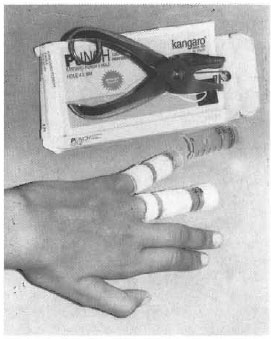- Volume 68 , Number 3
- Page: 332
A simple splint
To the Editor:
Recently we came across a simple, cost-effective finger splint recommended in patients with finger-tip lacerations, phalangeal fractures, dislocations, mallet and boutonniere deformities (1, 2). We recommend this split with slight modifications for mobile flexion deformities of the fingers in leprosy patients.
This splint is made from a disposable hypodermic syringe. The plunger is discarded and the body is longitudinally split with a pair of stout scissors. To prevent trauma, the edges are rounded off with a blunt file and a number of small holes are made in the body of the syringe with a hot, large-bore needle to allow for evaporation of sweat and prevent sogginess. We used an ordinary paper punch (see figure) or a soldering iron for the same purpose with comparable results. Alternatively, a piece of gauze wrapped around the finger to be splinted would probably serve this purpose. The splint is then placed on the dorsal or volar aspect of the finger and secured in place by two strips of adhesive tape. Depending upon the size of the finger, a custom-made splint to fit an individual finger can be created using the appropriate syringe-usually 10 cc for adults and 5 cc for children are suitable; 20 cc can be used for the thumb. This splint compares favorably with other methods used to prepare such a "gutter splint" that require additional materials, such as wood, steel, PVC, plaster of Paris or aluminum. It can easily be made, is convenient to use, nontraumatic, light in weight, and practically free of cost.

- Ranju Rai, M.D.
Inderjeet Kaur, M.D., M.N.A.M.S.
Bhushan Kumar, M.D., N.M.A.M.S.
Professor and Head
Department of Dermatology, Venereology and Leprology
Postgraduate Institute of Medical Research and Education
Chandigarh 160 012, India
REFERENCES
1. Dalal, M., Karmarkar, S. M., Yadav, P. and Nehete, R. A simple method to prepare a custom-made finger splint using a disposable hypodermic syringe. Plast. Reconstr. Surg. 99(1997)2102-2103.
2. Gohankari, D. R. and Lalwani, N. R. Finger injury splints. Br. J. Plast. Reconstr. Surg. 46(1993)344.
Reprint requests to Dr. Kumar at the above address or Fax 91-0172-744401; email: kumarbhushan@hotmail.com